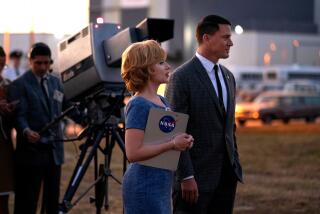A trip thatâs out of this world
For all but a few select humans, the way to outer space -- the real outer space, not the one where the Cylons live -- has been through a TV screen. You can climb to the top of Mt. Everest, or trek to the South Pole or go down under the sea and see it for yourself, but space is still the province of professionals: We know it only by the pictures they take.
The Discovery Channel marks the 50th anniversary of the National Aeronautics and Space Administration with âWhen We Left Earth: The NASA Missions,â|when+we+left+earth|WWLE+-+Alone|Google+NASA+-+WWLE+- +Specific a six-part, three-night series crafted from what a network news release describes as âNASAâs own secret film vaults.â (I imagine deep caverns, guardhouses, razor wire, steel doors, a man in a felt hat carrying a bullwhip.) An unofficial follow-up to last yearâs blockbuster âPlanet Earth,â it has been made to gladden the hearts of owners of High Definition televisions and will possibly inspire their purchase by others.
It was not, of course, originally filmed in HD, because although they were putting men in space in the â60s and â70s, there was yet much work to do on home-entertainment technology. But the curling old stock has been rehabilitated, copied, digitized, restored and remastered -- a good idea in any case, given how perishable it is -- and it should look very nice on that big TV of yours, as it does even on that little TV of mine.
This isnât the first time NASA has let this stuff out -- there was the 1989 Academy Award-nominated documentary âFor All Mankind,â which contained 80 minutes of unseen footage, and last yearâs British documentary on the Apollo missions, âIn the Shadow of the Moon,â which Discovery will give its broadcast premiere June 29. But there is more of it here, as much as you are going to see in one place any time soon.
My first view of the space race, as we used to call it back when it seemed like a contest, was as a small person in pajamas wakened early to watch rockets lift off live from the East Coast, meaning that space exploration will forever be entwined in my mind with the taste of pre-sweetened cold cereal. There was an immutable routine to these things, spread over days: liftoff, flight (weightless astronauts doing tricks with pens), return, splashdown, retrieval, quarantine, all narrated in my memory by Walter Cronkite, who is glimpsed here.
In the late days of the Shuttle and with the International Space Station orbiting out of mind, we have come to take astronauts for granted, but they were ticker-tape culture heroes then on a par with sports stars and movie actors. As fliers who werenât involved in, you know, bombing anything, yet were continually putting their own lives at risk, they were especially attractive: Indeed, they were potentially leading the country into a post-national, interstellar future, when we would all be simply citizens of Earth and aliens would come only from other planets. Wasnât John Glennâs spacecraft called the Friendship 7?
That is the spirit here. Although âWhen We Left Earthâ covers the entirety of NASA missions from Mercury to Gemini to Apollo, from Skylab to Hubble, this is not an in-depth history of a large, complicated and often politically charged subject but a moving-picture book of a great, sometimes hair-raising, even deadly adventure. Most of the surviving main players are here, the oldest and boldest now white-haired (if haired at all), but inspired to youthfulness by reminiscence; clearly, they were in it for the fun.
And it isnât so much that the pictures illustrate the story as that the story gives the pictures context. But even forgetting the context, itâs quite a show. The NASA cameramen, including the astronauts themselves, didnât just point and shoot; they worked with style and sensitivity, and there is a poetry in the images that matches the essence of its huge and elevated subject: the glow of a Florida sunrise, the classical repose of a big white rocket on a launch pad and the volcanic smoke and fire of its liftoff.
Spacecraft and spacemen, sharp-edged and glowing, exploring the surface of the moon, or floating in the crystal-clear stillness of space, sailing along at 17,000 miles an hour, the Earth spinning beneath them -- I mean, wow.
--
-
âWhen We Left Earth: The NASA Missionsâ
Where: Discovery Channel
When: 9 p.m. Sunday
Rating: TV-G (suitable for all ages)
More to Read
Sign up for The Wild
Weâll help you find the best places to hike, bike and run, as well as the perfect silent spots for meditation and yoga.
You may occasionally receive promotional content from the Los Angeles Times.







